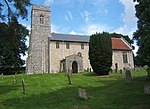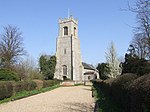Flixton Quarry
Geological Conservation Review sitesSites of Special Scientific Interest in Suffolk

Flixton Quarry is a 0.7 hectares (1.7 acres) geological Site of Special Scientific Interest 3.75 miles (6.04 km) south-west of Bungay in the English county of Suffolk. It is a Geological Conservation Review site located in the parish of Homersfield. This site has sands and gravels which are thought to be a glacial outwash dating to the most extreme ice age of the Pleistocene epoch, the Anglian glaciation around 450,000 years ago. It is described by Natural England as important because of its relationship with deposits of the succeeding Hoxnian Stage.There is access to the site from the Angles Way footpath.
Excerpt from the Wikipedia article Flixton Quarry (License: CC BY-SA 3.0, Authors, Images).Flixton Quarry
B1062, East Suffolk St. Mary, South Elmham Otherwise Homersfield
Geographical coordinates (GPS) Address Nearby Places Show on map
Geographical coordinates (GPS)
| Latitude | Longitude |
|---|---|
| N 52.423 ° | E 1.367 ° |
Address
B1062
IP20 0EX East Suffolk, St. Mary, South Elmham Otherwise Homersfield
England, United Kingdom
Open on Google Maps










